Engine Light on JAGUAR XJ 2004 X350 / 3.G Owner's Manual
[x] Cancel search | Manufacturer: JAGUAR, Model Year: 2004, Model line: XJ, Model: JAGUAR XJ 2004 X350 / 3.GPages: 227, PDF Size: 4.22 MB
Page 131 of 227

4-60 On the Road
Use of Headlamps In Daylight
When visibility is poor the headlamps
with dipped beam setting should be
switched on so that the vehicle may be
seen more easily by other road users.
The instrument illumination dimmer
control adjusts the brightness of the panel
lighting.
Engine Oil Consumption
A certain amount of oil consumption is
normal. The rate of consumption will
depend on the following:
• The quality and viscosity of the oil.
• The amount of oxidation and dilution of the oil.
• Climatic conditions.
• The speed at which the engine is being operated.
• Road conditions.
Drivers should expect above normal
consumption when the engine is new,
and after running-in if high speeds are
sustained.
Winter Driving
Freeing a frozen door lock
Caution: Do not ap ply a proprietary
lock de-icer through the keyhole.
Should the lock beco me frozen, warm the
end of the key before use.
Windscreen wiper blades
Before driving away, clear any ice from
the windscreen and check that the wiper
blades are free. Switching on the heated
screen will accelerate this process.
The heated wiper park, if fitted, will come
on automatically.
Frost precautions
The correct concentration of coolant
must be maintained at all times when
‘topping up’ or ‘refilling’ the cooling
system.
Parking the Vehicle
When leaving the vehicle, remember the
following:
• Whenever the vehicle is being parked, apply the parkbrake and move the
gear selector to Park ‘P’.
• Do not leave children or pets in the vehicle unattended.
• Do not leave luggage or valuables on view. Always take your valuables with
you or lock them in the luggage
compartment.
• Remove the ignition key and spare keys, even when the vehicle is in your
garage.
• When the vehicle is unoccupied, close
all windows and lock all doors
securely.
• Park the vehicle where it can be seen. At night, park in a well-lit area.
• Ensure that the keys and the key transmitters are removed from the
vehicle before locking the doors,
and that all doors, the luggage
compartment and the hood are
closed.
Page 134 of 227

On the Road 4 - 63
Fuel and Refuelling
Before refuelling, switch off the ignition
and remove the key.
Note:Do not leave the ignition key in the
vehicle; vehicles have been stolen from
garage service/filling stations whilst the
driver is absent from the vehicle. It is
recommended that the vehicle is locked,
if left unattended.
Caution: No additives of any kind
(fuel or oil) must be put into the fuel
tank. Additives could reduce engine
life or affect exhaust emissions.
!WARNING:
1. Fuel vapour is highly flammable and in confined spaces is
explosive and toxic. In the event
of inadvertent spillage, and before
refuelling, always switch OFF the
engine. Do not use exposed flame
or light. Do not smoke. Do not
inhale fumes.
2. Do not fill the tank so that fuel is visible in the fuel filler intake
tube. This could cause spillage
and danger from exposed fuel.
Fuel Tank Filling
Caution: Your vehicle is fitted with
catalytic converters and must only be
filled with ‘Unleaded Fuel’.
The fuel filler flap release switch is
located in the knee bolster switchpack
below the fascia. The fi ller flap is on the
right-hand side of the vehicle.
A small arrow is shown on the fuel gauge
as a reminder on which side of the
vehicle the fuel filler flap is located. Open the fuel filler flap and turn the filler
cap anti-clockwise, a ¼ turn until
resistance is felt. Continue turning to
release the cap from the filler neck.
The cap is held by a retaining strap and
can be stowed over the hook on the flap
to allow easy access to fill the tank.
A warning label on the inside of the fuel
filler flap advises type/grade of fuel.
Page 137 of 227

4-66 On the Road
Fuel filler flap manual release
If the fuel filler flap fails to release it can
be manually unlocked as follows:
1. In the luggage compartment, remove
the carpet from the right-hand side,
behind the rear light. To do this, turn
the carpet securing screws a ¼ turn
and then firmly pull the top corner of
the carpet down.
2. Locate the fuel flap release mechanism and pull the knob rearwards. This will
release the flap to gain access to the
filler cap and enable the vehicle to be
refuelled.
3. Report the fault to a Jaguar Retailer. Unleaded fuel
All vehicles are fitted with a catalytic
system and can only use unleaded fuel.
Unleaded fuel must be used for the
emission control system to operate
properly. Its use will also reduce spark
plug fouling, exhaust system corrosion
and engine oil deterioration.
The preferred fuel should have an octane
rating of at least 95 RON (Research
Octane Number).
‘Super Green’ Plus 98 RON unleaded fuel
(where available) may be used as an
alternative to the standard 95 RON
unleaded fuel. Some countries have only 91 RON fuel
available. The vehicles in these countries
are specially calibrated to use this fuel.
Using unleaded fuel with an octane rating
lower than recomm
ended can cause
persistent, heavy ‘spark knock’ (a metallic
rapping noise). If severe, this can lead to
engine damage.
If a heavy ‘spark knock’ is detected even
when using fuel of the recommended
octane rating, or if you hear steady ‘spark
knock’ while holding a steady speed on
level roads consult a Jaguar Retailer to
have the problem corrected. Failure to do
so is misuse of the vehicle, for which
Jaguar Cars Limited, is not responsible.
However, occasional light ‘spark knock’
for a short time while accelerating or
driving up hill, may occur.
Emission control components
Owing to the legislative requirements or
options available in some countries,
a Jaguar Retailer should be consulted
where any doubt exists as to the precise
emission control system specification of
this vehicle.
Page 147 of 227

5 - 8 Climate Control
Windscreen Defrost/Demist
Frost and heavy mistingTo remove frost or heavy
misting from the windscreen,
press the DEF button.
• The blower switches on automatically at a high speed but the speed can be
increased or decrea sed manually if
required.
• Air conditioning switches on automatically and cannot be
deselected.
• Recirculation is ca ncelled and cannot
be selected.
• The front screen heater and the rear screen heater/door mirror heaters
switch on automatically, provided the
engine is running.
To deselect defrost mode, press AUTO
(recommended operating mode).
Light misting To prevent or remove light
windscreen misting, select
manual air distribution to
windscreen and feet
(see page 5 - 9).
Heated Screens and Door
Mirrors
The front ( F) and
rear ( R) screen heaters
may be switched on and
off in any mode, including system off,
but only operate when the engine is
running. The door mirror heaters are also
controlled by the rear screen heater
button.
The front screen heater (if fitted) switches
off automatically after 6½ minutes.
The rear screen and door mirror heaters
switch off automatica lly after 21 minutes.
The windscreen heaters may be manually
deselected during the timed period using
the push buttons.
In cold ambient conditions, at the start of
a journey, the front and rear screen
heaters may switch on automatically for
the timed period.
Where a front screen he ater is not fitted,
the windscreen has a wiper park zone
heater which operates automatically with
no manual control.
Note: The top three lines of the rear
screen pattern are a concealed antenna
system and do not defrost the rear screen.
Air Conditioning
Press to switch the air
conditioning on or off.
The air conditioning system is
controlled automatically in AUTO mode.
Deselecting A/C cancels AUTO mode.
The air conditioning system is also
switched on automatically in defrost
mode (DEF) but cann ot be deselected.
Blower Speed
Set the blower speed as
required with the rotary
control knob. Blower speed is
shown as a series of bars on the
LCD screen.
When operating in AUTO mode, blower
speed is controlled automatically (but not
displayed) and any adjustment of the
knob will cancel AUTO mode.
Note: In AUTO mode, the blower only
operates at low speed, if heating is
required, until the engine is warm.
Page 163 of 227
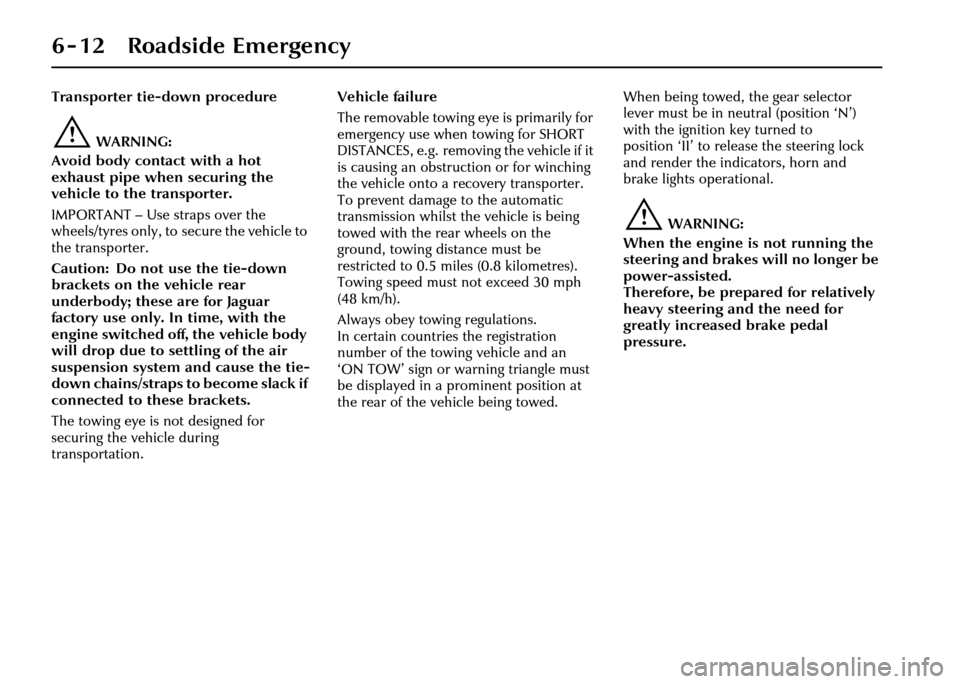
6 - 12 Roadside Emergency
Transporter tie-down procedure
!WARNING:
Avoid body contact with a hot
exhaust pipe when securing the
vehicle to the transporter.
IMPORTANT – Use straps over the
wheels/tyres only, to secure the vehicle to
the transporter.
Caution: Do not use the tie-down
brackets on the vehicle rear
underbody; these are for Jaguar
factory use only. In time, with the
engine switched off, the vehicle body
will drop due to settling of the air
suspension system and cause the tie-
down chains/straps to become slack if
connected to these brackets.
The towing eye is not designed for
securing the vehicle during
transportation. Vehicle failure
The removable towing eye is primarily for
emergency use when towing for SHORT
DISTANCES, e.g. removing the vehicle if it
is causing an obstruct
ion or for winching
the vehicle onto a re covery transporter.
To prevent damage to the automatic
transmission whilst the vehicle is being
towed with the rear wheels on the
ground, towing distance must be
restricted to 0.5 miles (0.8 kilometres).
Towing speed must not exceed 30 mph
(48 km/h).
Always obey towing regulations.
In certain countries the registration
number of the towing vehicle and an
‘ON TOW’ sign or warning triangle must
be displayed in a prominent position at
the rear of the vehicle being towed. When being towed, the gear selector
lever must be in neutral (position ‘N’)
with the ignition key turned to
position ‘II’ to release the steering lock
and render the indicators, horn and
brake lights operational.
!WARNING:
When the engine is not running the
steering and brakes will no longer be
power-assisted.
Therefore, be prepared for relatively
heavy steering and the need for
greatly increased brake pedal
pressure.
Page 173 of 227
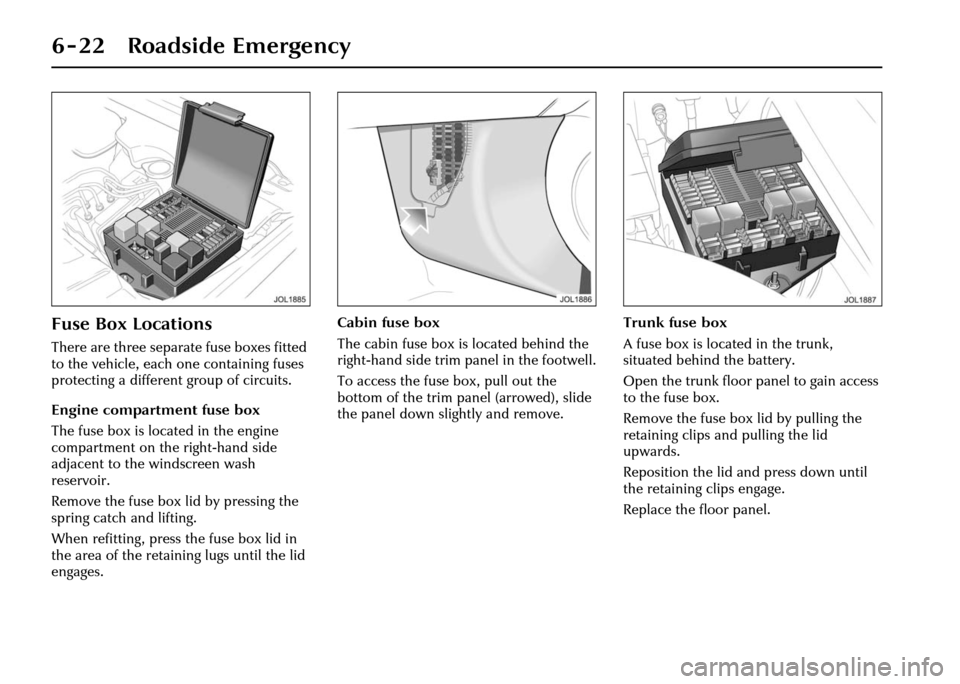
6 - 22 Roadside Emergency
Fuse Box Locations
There are three separate fuse boxes fitted
to the vehicle, each one containing fuses
protecting a different group of circuits.
Engine compartment fuse box
The fuse box is located in the engine
compartment on the right-hand side
adjacent to the windscreen wash
reservoir.
Remove the fuse box lid by pressing the
spring catch and lifting.
When refitting, press the fuse box lid in
the area of the retaining lugs until the lid
engages. Cabin fuse box
The cabin fuse box is located behind the
right-hand side trim panel in the footwell.
To access the fuse box, pull out the
bottom of the trim panel (arrowed), slide
the panel down slightly and remove.
Trunk fuse box
A fuse box is located in the trunk,
situated behind the battery.
Open the trunk floor panel to gain access
to the fuse box.
Remove the fuse box lid by pulling the
retaining clips and pulling the lid
upwards.
Reposition the lid and press down until
the retaining clips engage.
Replace the floor panel.
Page 175 of 227
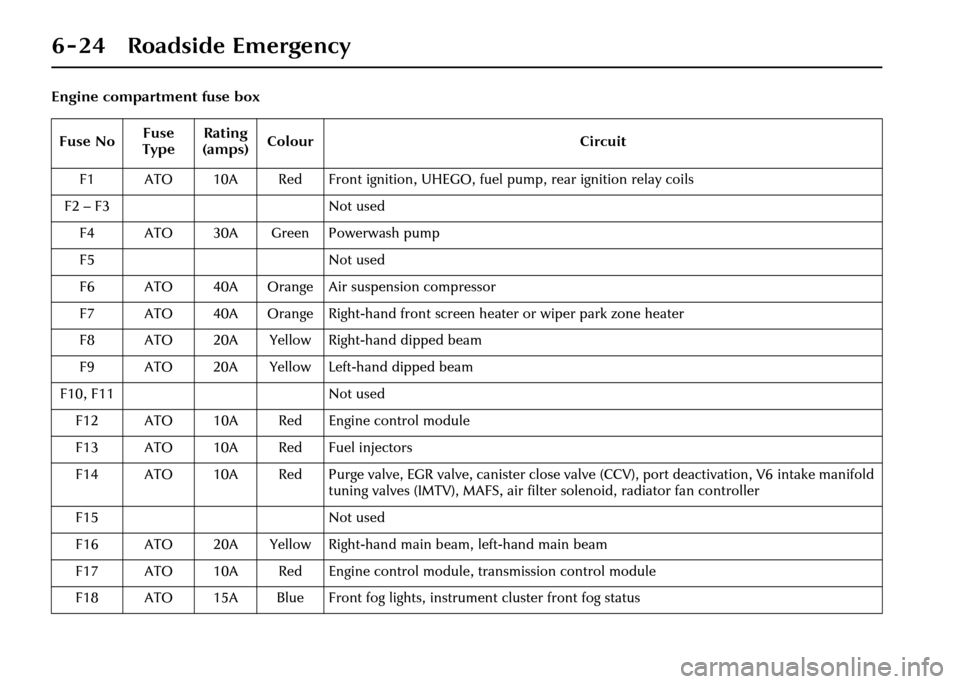
6 - 24 Roadside Emergency
Engine compartment fuse boxFuse No Fuse
Type Rating
(amps) Colour
Circuit
F1 ATO 10A Red Front ignition, UHEGO, fu el pump, rear ignition relay coils
F2 – F3 Not used
F4 ATO 30A Green Powerwash pump
F5 Not used
F6 ATO 40A Orange Air suspension compressor
F7 ATO 40A Orange Right-hand front screen heater or wiper park zone heater
F8 ATO 20A Yellow Right-hand dipped beam
F9 ATO 20A Yellow Left-hand dipped beam
F10, F11 Not used
F12 ATO 10A Red Engine control module
F13 ATO 10A Red Fuel injectors
F14 ATO 10A Red Purge valve, EGR valve, canister close valve (CCV), port deactivation, V6 intake manifold
tuning valves (IMTV), MAFS, air filter solenoid, radiator fan controller
F15 Not used
F16 ATO 20A Yellow Right-hand main beam, left-hand main beam
F17 ATO 10A Red Engine control module, transmission control module
F18 ATO 15A Blue Front fog lights, instrument cluster front fog status
Page 177 of 227

6 - 26 Roadside Emergency
Cabin fuse boxFuse No Fuse
Type Rating
(amps) Colour
Circuit
F1 ATO 10A Red Climate control unit, fan, screen heaters and wiper relay coils, smog sensor
F2 ATO 5A Tan Radiator fan controller, cruise control switch, adaptive cruise control
F3 ATO 5A Tan Rear outer seat, electrochromic mirror, driver seat heater, electric parkbrake, left and right-hand HID lamps levelling, left and right-hand seat belt switches
F4 ATO 5A Tan Instrument cluster
F5 – F6 Not used
F7 ATO 5A Tan Cigar lighter, sunroof module, electric park brake switch illumination, accessory relays (trunk fuse box)
F8 ATO 5A Tan Instrument cluster
F9 ATO 10A Red Left-hand direction indicator and repeater
F10 ATO 5A Tan Glove compartm ent door motor and lamps
F11 ATO 5A Tan Radio muting (engine start), ignition feed
F12 ATO 10A Red Front electronic module (FEM), passenger mirror
F13 ATO 20A Yellow Rear electronic module (REM), door locks
F14 ATO 10A Red Courtesy light, footwell lamps, rain sensor, FEM
F15 ATO 5A Tan ECM, FEM, instrument cluster air bag fa ult lamp, instrument cluster ignition (run/start)
F16 ATO 5A Tan Diagnostic connector
Page 184 of 227
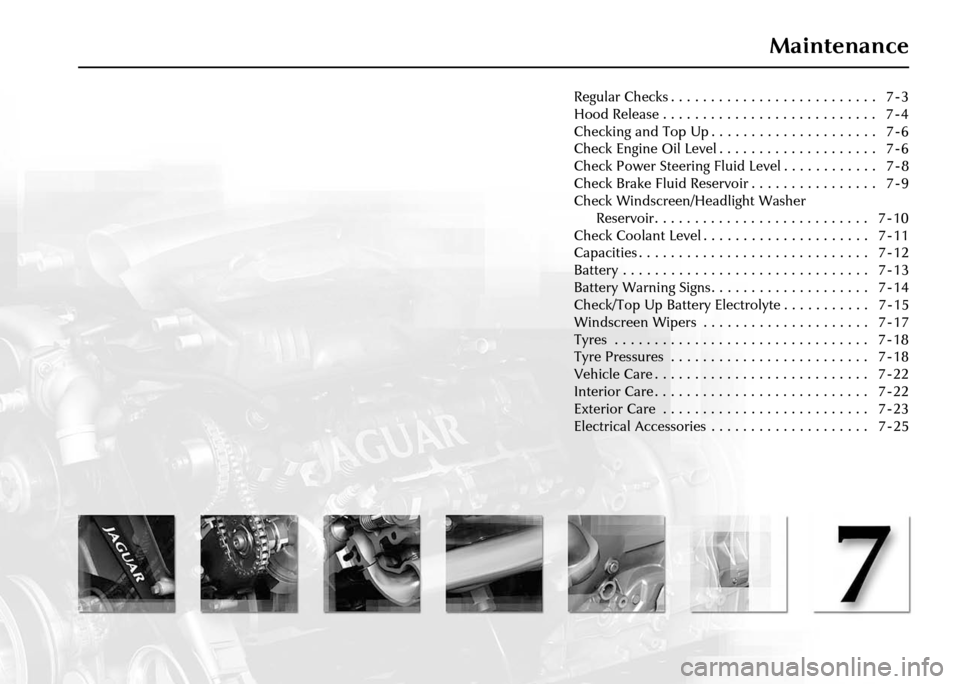
Maintenance
Regular Checks . . . . . . . . . . . . . . . . . . . . . . . . . . 7 - 3
Hood Release . . . . . . . . . . . . . . . . . . . . . . . . . . . 7 - 4
Checking and Top Up . . . . . . . . . . . . . . . . . . . . . 7 - 6
Check Engine Oil Level . . . . . . . . . . . . . . . . . . . . 7 - 6
Check Power Steering Fluid Level . . . . . . . . . . . . 7 - 8
Check Brake Fluid Reservoir . . . . . . . . . . . . . . . . 7 - 9
Check Windscreen/Headlight Washer Reservoir. . . . . . . . . . . . . . . . . . . . . . . . . . . 7 - 10
Check Coolant Level . . . . . . . . . . . . . . . . . . . . . 7 - 11
Capacities . . . . . . . . . . . . . . . . . . . . . . . . . . . . . 7 - 12
Battery . . . . . . . . . . . . . . . . . . . . . . . . . . . . . . . 7 - 13
Battery Warning Signs. . . . . . . . . . . . . . . . . . . . 7 - 14
Check/Top Up Battery Electrolyte . . . . . . . . . . . 7 - 15
Windscreen Wipers . . . . . . . . . . . . . . . . . . . . . 7 - 17
Tyres . . . . . . . . . . . . . . . . . . . . . . . . . . . . . . . . 7 - 18
Tyre Pressures . . . . . . . . . . . . . . . . . . . . . . . . . 7 - 18
Vehicle Care . . . . . . . . . . . . . . . . . . . . . . . . . . . 7 - 22
Interior Care . . . . . . . . . . . . . . . . . . . . . . . . . . . 7 - 22
Exterior Care . . . . . . . . . . . . . . . . . . . . . . . . . . 7 - 23
Electrical Accessories . . . . . . . . . . . . . . . . . . . . 7 - 25
Page 186 of 227
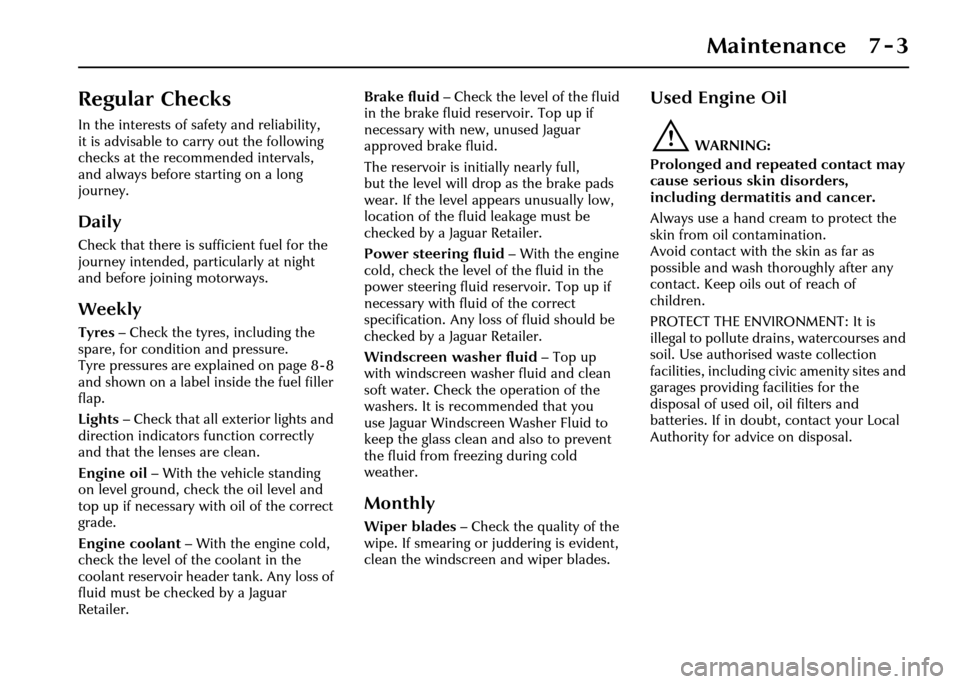
Maintenance 7 - 3
7 Maintenance
Regular Checks
In the interests of safety and reliability,
it is advisable to carry out the following
checks at the recommended intervals,
and always before starting on a long
journey.
Daily
Check that there is sufficient fuel for the
journey intended, particularly at night
and before joining motorways.
Weekly
Tyres– Check the tyres, including the
spare, for condition and pressure.
Tyre pressures are explained on page 8 - 8
and shown on a label inside the fuel filler
flap.
Lights – Check that all exterior lights and
direction indicators function correctly
and that the lenses are clean.
Engine oil – With the vehicle standing
on level ground, check the oil level and
top up if necessary with oil of the correct
grade.
Engine coolant – With the engine cold,
check the level of the coolant in the
coolant reservoir header tank. Any loss of
fluid must be checked by a Jaguar
Retailer. Brake fluid
– Check the level of the fluid
in the brake fluid reservoir. Top up if
necessary with new, unused Jaguar
approved brake fluid.
The reservoir is initially nearly full,
but the level will drop as the brake pads
wear. If the level appears unusually low,
location of the fluid leakage must be
checked by a Jaguar Retailer.
Power steering fluid – With the engine
cold, check the level of the fluid in the
power steering fluid reservoir. Top up if
necessary with fluid of the correct
specification. Any loss of fluid should be
checked by a Jaguar Retailer.
Windscreen washer fluid – Top up
with windscreen washer fluid and clean
soft water. Check the operation of the
washers. It is recommended that you
use Jaguar Windscreen Washer Fluid to
keep the glass clean and also to prevent
the fluid from freezing during cold
weather.
Monthly
Wiper blades – Check the quality of the
wipe. If smearing or juddering is evident,
clean the windscreen and wiper blades.
Used Engine Oil
!WARNING:
Prolonged and repeated contact may
cause serious skin disorders,
including dermatitis and cancer.
Always use a hand cream to protect the
skin from oil contamination.
Avoid contact with the skin as far as
possible and wash thoroughly after any
contact. Keep oils out of reach of
children.
PROTECT THE ENVIRONMENT: It is
illegal to pollute drai ns, watercourses and
soil. Use authorised waste collection
facilities, including civic amenity sites and
garages providing fa cilities for the
disposal of used oi l, oil filters and
batteries. If in doubt, contact your Local
Authority for advice on disposal.